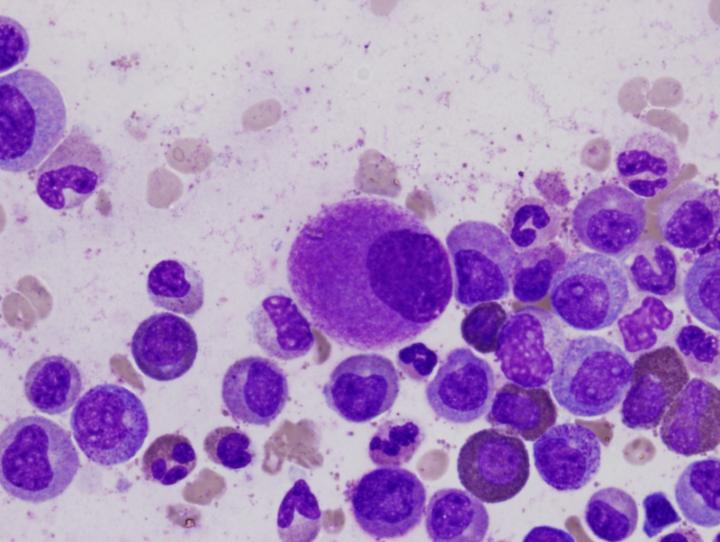Discovery of an embryonic switch for cancer stem cell generation

An oversized bone marrow cell, typical of chronic myeloid leukemia, is shown. Credit: Difu Wu
An international team of scientists, headed by researchers at UC San Diego School of Medicine and UC San Diego Moores Cancer Center, report that decreases in a specific group of proteins trigger changes in the cancer microenvironment that accelerate growth and development of therapy-resistant cancer stem cells (CSCs).
The discovery suggests the basis for a potential new therapeutic approach to eradicate blood cancers, which affect more than 1.1 million Americans. In fact, researchers found that in cell and mouse models, a treatment that employed a targeted monoclonal antibody effectively impaired the ability of CSCs to regenerate and made them easier to eradicate with existing enzyme-targeted (tyrosine kinase inhibitor) therapies.
The findings are published in the November 30 online issue of Proceedings of the National Academy of Sciences.
“This is the first description of cancer stem cell generation through decreased expression of a transcriptional repressor of an embryonic pattern of alternative splicing that enhances stem cell self-renewal and survival,” said senior author Catriona Jamieson, MD, PhD, associate professor of medicine, chief of the Division of Regenerative Medicine and director of Stem Cell Research at Moores Cancer Center.
“Rather than acquiring multiple DNA mutations, as was previously thought, cancer stem cells in chronic myeloid leukemia (CML) switch to embryonic RNA splicing, which enhances their capacity to self-renew or clone themselves,” said Jamieson. “If we can detect and turn off embryonic splicing, we may be able to prevent cancer stem cells from propagating themselves. Also, if we target embryonic versions of proteins that are re-expressed by cancer, like CD44 variant 3, with specific antibodies together with tyrosine kinase inhibitors, we may be able to circumvent cancer relapse – a leading cause of cancer-related mortality.”
Jamieson and colleagues showed that downregulation of Muscleblind-like 3 (MBNL3) RNA binding proteins resulted in re-expression of a human embryonic stem cell-specific alternative splicing gene regulatory network – a mechanism that controls embryonic stem cell pluripotency and fate. One effect was reprogramming of progenitor cells into CSCs in blast crisis CML. Blast crisis occurs when there is 20 percent or more leukemia stem cells in the blood or bone marrow. It is the most advanced stage of leukemia.
The researchers found, however, that treatment with a humanized pan-CD44 monoclonal antibody and a targeted tyrosine kinase antagonist disrupted development of CSCs in their protected microenvironment, forcing them to enter the blood stream where dasatinib – a tyrosine kinase inhibitor – could effectively target them.
###
Co-authors include Frida Holm, Eva Hellqvist, Cayla N. Mason, Shawn A. Ali, Nathaniel Delos-Santos, Christian L. Barrett, Kelly A. Frazer and Anil Sadarangani, UC San Diego; Hye-Jung Chun, Richard A. Moore and Marco A. Marra, Canada's Michael Smith Genomes Sciences Centre; Mark D. Minden, Princess Margaret Hospital, Toronto; and Valerie Runza, Roche Pharmaceutical Research and Early Development, Germany.
Funding for this research came, in part, from the California Institute for Regenerative Medicine (DR1-01430), Leukemia Lymphoma Society Quest for Cures, Ratner Family Foundation, Sanford Stem Cell Clinical Center, Swedish Research Council and Swedish Childhood Cancer Foundation.
Full study: http://doi.
Media Contact
All latest news from the category: Life Sciences and Chemistry
Articles and reports from the Life Sciences and chemistry area deal with applied and basic research into modern biology, chemistry and human medicine.
Valuable information can be found on a range of life sciences fields including bacteriology, biochemistry, bionics, bioinformatics, biophysics, biotechnology, genetics, geobotany, human biology, marine biology, microbiology, molecular biology, cellular biology, zoology, bioinorganic chemistry, microchemistry and environmental chemistry.
Newest articles

Superradiant atoms could push the boundaries of how precisely time can be measured
Superradiant atoms can help us measure time more precisely than ever. In a new study, researchers from the University of Copenhagen present a new method for measuring the time interval,…

Ion thermoelectric conversion devices for near room temperature
The electrode sheet of the thermoelectric device consists of ionic hydrogel, which is sandwiched between the electrodes to form, and the Prussian blue on the electrode undergoes a redox reaction…

Zap Energy achieves 37-million-degree temperatures in a compact device
New publication reports record electron temperatures for a small-scale, sheared-flow-stabilized Z-pinch fusion device. In the nine decades since humans first produced fusion reactions, only a few fusion technologies have demonstrated…





















